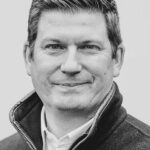Free Business Advice Drives Sustainable Growth for Kent Arable Farm
Edward Hutley
May, 23 2023A ten-year sustainability plan put in place just over a year ago at Squerryes Estate at Westerham in Kent has provided a framework for the business, as it navigates its way through the agricultural transition.
With six priorities – access, community, terroir, ecology, flooding and carbon – the plan was developed to show how the estate could continue to create joy for future generations; reflecting its motto ‘Licet Esse Beatis’ (it is permitted to be joyful).

Owner Henry Warde explains that the sustainability plan encompasses everything that is important to the 1000ha estate, which has already diversified into sparkling wine production, retail and hospitality to increase revenues and complement its arable farming operations.
“We’ve got our sustainability goals – now we need a baseline for our farming activities so that we make the right decisions about improving our position, reducing emissions and delivering progress,” he said.
“Having set out our aims and ambitions until 2031, we need to make the year-to-year changes which will help us to achieve them.”
Carbon Audit
For this reason, Mr Warde opted to have a carbon emissions and efficiency audit on offer from the Future Farming Resilience Fund, which was set up by Defra to offer free support and advice to farming businesses.
The audit, which was carried out by us here at Ceres Rural, was done on the 400ha arable enterprise, with the aim of focussing on the farming practice, not the wider estate.
Cropping at Squerryes includes winter wheat, winter oilseed rape, winter and spring beans and winter oats, along with a small area of forage maize in some years for a local anaerobic digestion plant.
Cultivations are being reduced, wherever possible, without compromising yield. The farm is moving away from rotational ploughing and min-till techniques as direct drilling is trialled on suitable fields – the first crops established in this way will be harvested later this year.
In line with most arable farms, the carbon audit identified nitrogen fertiliser as the main emissions culprit, accounting for around 80% of the farm’s carbon footprint due to the nitrous oxide emissions arising from its use.
Other areas, such as fuel use, were contributing much less. “Overall, emissions were 50% higher than the net zero position we would like to get to,” revealed Mr Warde. “Discovering that figure gave us the impetus to start to get the balance right.”
The audit also showed the impact of reducing nitrogen rates by up to 40kg/ha, for example, as well as how the use of cover crops could help to retain carbon in the farming system.
“It explored various scenarios, so that we could make decisions relevant for our situation.”
Recommendations
The carbon audit report we produced contained recommendations for the farming operation, many of which are now being implemented.
These include making rotational changes, using digestate on the farm, looking for other ways to reduce reliance on bagged nitrogen fertiliser and introducing techniques to improve Nitrogen Use Efficiency (NUE).

A focus on soil health has also been implemented, so that soil organic matter levels improve and nutrient cycling starts to take place.
“The start was a good look at the rotation,” explained farming consultant George Catchpole. “Beans came in to replace second wheats and provide a fertility benefit, cover crops have been introduced ahead of spring crops for their ability to scavenge nutrients and improve soil function and maize is being dropped, due to soil damage concerns.”
“The use of digestate was also recommended, to improve soil health and provide nutrients, mainly N and K, while reducing bagged fertiliser costs”, he added.
In addition, fertiliser applications are now being matched to yield potential and crop requirements, so that inputs and outputs are more closely aligned.
“Targeting of fertiliser is an easy win,” added Mr Catchpole. “Not only by reducing rates on less productive sites, but also by using fine-tuning techniques such as sap testing and leaf analysis.”
Mr Warde confirmed that these initial actions are underway. “Being able to discuss the recommendations with Ceres Rural has been very helpful and I’m now getting my head around more regenerative practices.”
Other Opportunities
The report also highlights future opportunities for reducing emissions and for carbon sequestration.
For this, it included other areas of the estate, looking at the role of hedgerows and field corners, not just the productive arable land.
“Some of these areas on the farm are hiding in plain sight,” noted Mr Warde. “They help to simplify the decision-making between carbon and economic crop production and will have a role in delivering public goods.”
Already, there are two woodland Higher-Tier Countryside Stewardship agreements in place, as well as a Mid-Tier Countryside Stewardship scheme on arable and grassland.
The farm is also in the Darent Valley Partnership, a large-scale initiative working at scale for nature recovery and one of Defra’s selected Landscape Recovery projects.
“Small changes made at the farm level can have a big impact,” continued Mr Warde. “Being part of a project like this shows the potential that can be achieved when we work with others and highlights what more can be done.”
What is the Future Farming Resilience Fund?
Running until March 2025, farmers can access one-to-one, free-of-charge advice and direction from the Defra initiative, helping them to identify changes as BPS support is reduced and ELMS is introduced.
The Ceres Rural packages allow farmers to choose from a range of items, depending on their needs and level of detail required – gold, silver and bronze options are available.
Farm resilience reports, carbon audits, benchmarking updates, business plans, budgets and follow-up business reviews are accessible, with our consultants involved in the collection of data and delivery of results. Some 500 reports will be produced by Ceres Rural this year.
To register your interest in receiving free farm business advice, click here.
About Squerryes Sparkling Wine

Squerryes has transformed from being a traditional estate with farming and property interests to including an award-winning sparkling wine business as part of its offering.
Back in 2006, the decision was taken to introduce a third dimension to the business, with a vineyard being planted on the chalk soils. Since then, Squerryes has become well-known for its vintage sparking wine, produced from the grapes grown on the North Downs estate.
Having won a gold medal for six consecutive vintages in the World Championships of champagne and sparkling wine, Squerryes was crowned National Champion in 2021.
The estate also has a fine-dining restaurant, garden café, estate delicatessen and cellar door, set up with the aim of creating new income streams to match those produced from its agricultural activities.






